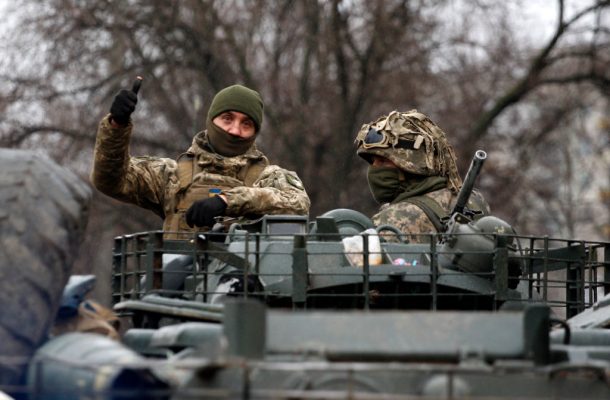7 lessons from Ukraine

When the Russian military defeated the Ukrainians comprehensively in 2014 to seize the Donbas region, there seemed little doubt that the balance of power was moving more in Russia’s favour. But in 2022, President Volodymyr Zelensky and the Ukrainian military have been showing us something quite different.
The Ukrainian military reinvented itself and learned from its defeat, with the result that it has inflicted major defeats and reverses on the much larger Russian military machine since President Vladimir Putin began his war.
There are key lessons for Australia from Ukraine.
You can reinvent your military in eight years
The unexpected success of Ukraine’s military has been driven by the sense of urgency for change after 2014’s defeat.
The obvious insight for Australia and our defence organisation is that while we have been good at describing our increasingly bleak strategic environment, we have failed to act with any urgency to improve our military capability.
Perhaps we don’t believe our own assessment about the growing risk of conflict, even with Putin’s example in front of us. Defence’s plans to spend its growing budget only start to deliver increased military power in the second half of the 2030s—13 years from now and then only slowly.
This week’s announcements on the AUKUS update and buying missiles earlier than planned don’t change much. We still don’t make a single missile for our forces here in Australia. That puts us at considerable risk during a conflict, given the huge numbers of missiles used in modern war—as we see in Ukraine—and our extended, slow supply chains.
It’s taken Defence from July 2020, when a plan to establish a local missile industry was announced in the strategic update, until now to select the two big US defence companies which already sell us most of our missiles as ‘initial industry partners’.
And this is under an ‘accelerated’ approach driven by the prime minister and defence minister. There’s still no timeline for when the first missile will come off an Australian production line.
Partners are important, but allies are essential
Zelensky and his military have relied on extensive materiel support from partners in the EU and NATO, as well as countries including Australia. The flow of anti-armour missiles and other supplies, along with intelligence, has helped Ukraine sustain the war and inflict defeats on Putin’s badly prepared and supported forces.
This materiel assistance has enabled the Ukrainians to roll back the Russians around Kyiv, but it has not prevented horrific mass killing and destruction by Putin’s forces. The Russian withdrawal in the north is likely about massing to reinforce their attacks around the Donbas region.
US President Joe Biden and other NATO leaders have agonised over what they will and won’t give to Ukraine for its defence and erred on the side of giving nothing that might anger Putin enough for him to escalate the conflict. These leaders have also been at pains to let Putin know that US and NATO forces will not set foot in Ukraine or fight Russian forces there because Ukraine is not a NATO ally.
This message has some narrowly encouraging aspects for Australia, Japan and even the Philippines, which are all US allies, but it’s disturbing for wider Indo-Pacific security, given the non-ally status of key partners like Vietnam, Indonesia and, of course, Taiwan.
The world helps those who help themselves
Before Putin’s war began, most external assessments were that Russia would gain a quick victory. There were few plans by the US and NATO or the EU to directly assist the Ukrainians, given it was expected to hopefully not happen at all or be over quickly.
Once it was obvious that the Ukrainian military had not just withstood the initial Russian attacks but inflicted stunning reverses (from the first day at Hostomel airport and against elite Russian forces trying to capture or kill Zelensky), the US, NATO and the EU were compelled to help Ukraine continue the fight. Their populations demanded it and continue to do so.
And every day Zelensky and his people succeed, they attract more support. Last week, the Australian government promised to airlift Bushmaster armoured vehicles to Ukraine.
The contrast with the rapid folding of the Afghan government and its well-equipped military, which turned out to be entirely dependent on foreign forces, is stark.
If the Ukraine invasion turns into a long war, a key factor will be whether materiel support to the Ukrainians is sufficient for them to sustain their operational success, or whether attrition will wear them down, handing an advantage to Putin.
The lesson for Australia is to have what we used to call ‘self-reliant’ defence forces, not just forces that plug into larger US plans and operations. That’s why domestic missile production is so important.
Plan for the fight you’re going to have
The Ukrainian forces have come a long way since 2014. Not only have they defeated elite airborne troops and ‘Spetsnaz’ special forces, they’ve defeated Russia’s modernised integrated military. This was possible because the Ukrainians developed new operating concepts and adopted new weapons.
Small mobile units with effective anti-armour weapons, who knew their terrain well, took advantage of their geography and ambushed traditional Russian formations and their extended, badly protected supply lines.
A ponderous, traditional adversary with poor planning faced agile, mobile, lethal forces. The morale of Russian fighting units has collapsed, while operational success has fed the Ukrainian military’s confidence and energy—despite Russia’s overwhelming numbers in personnel and equipment.
The Ukrainians are also using Starlink satellite communication systems provided by Elon Musk, smartphones and even Facebook pages to employ Turkish armed drones and anti-tank missiles like the Javelin and NLAW, innovating at the speed required by war.
The contrast between what the Ukrainians have shown is possible and the sluggish pace of Australia’s processes for integrating new concepts, technologies and systems into the ‘integrated joint force’ is embarrassing.
New concepts and weapons applied in the actual geography that the Australian Defence Force would operate in during a war in our region will be definitive for success or defeat. Yet, the ADF has not been clear about scenarios for conflict in our region. Without this as a starting point, the result is hypotheticals about the virtues of heavy armour, combined arms and multi-domain operations, resulting in a force with a little bit of everything and not much of anything.
War is a real and present danger
The term ‘post-war Europe’ is dead. NATO members that resented US presidents Barack Obama, Donald Trump and Biden insisting they spend more on their defence have woken up to this nasty reality.
Australian government policy says major conflict involving our defence forces is credible within 10 years. This is a dramatic change in what, before the 2020 defence strategic update, had been the most stable fundamental planning assumption underpinning defence strategy, military capability, preparedness, and defence spending for more than 30 years.
However, actual plans for military capability that dictate how Australia’s growing defence budget ($48.6 billion in the March 2022 budget, on the way to $73.7 billion by 2030) is spent have not changed much. And not in any way that increases Australia’s military power before the mid-2030s and later.
The AUKUS nuclear submarine initiative is an example of where the new plans are even slower to deliver than before 2020, while the recently announced intent to grow the ADF by 18,500 personnel by 2040 is simply delivering the people to operate the force structure Defence convinced the government to agree to in the 2016 white paper.
Deterrence requires real military power
Before Putin began his attack in Ukraine, US and NATO leaders foreshadowed severe economic consequences for him and Russia. NATO leaders met and expressed resolution.
None of that mattered when Putin ordered the attack on 24 February and it has not mattered since.
The unexpected and very welcome unity of the EU, US and NATO, joined by other international partners, in imposing rapid, sweeping and deep economic and political sanctions has gone far beyond what Putin and his advisers would have contemplated. It has almost certainly gone much further than the EU, US NATO and others had considered before the war.
NATO members’ growing commitment to rearm urgently and to strengthen NATO power on Russia’s periphery is also welcome and may deter further Russian aggression, depending on how the Ukrainian war unfolds.
But Putin’s plan was to attack Ukraine, not NATO. He has done so and continues to do so despite all this deterrent activity. For all the triumphalism about unity and deterrence, we have all failed the moment. Setting ‘red lines’ around the use of chemical weapons simply says NATO is willing to accept any other actions, including mass deaths and destruction of entire cities through aerial, artillery and naval bombardment.
Arguably, all this sanctions unity and determination to increase Europe’s military power has been enabled by Ukraine’s defiance in the face of Russian forces. If its military had folded as expected (and Zelensky had accepted the US offer of a ride out, instead of staying and demanding ammunition), we may not have seen such international cooperation and resolve.
In that alternative future, we may have just seen more of the division and vacillation on display in European security discussions over the past decade, which would have empowered the aggressive autocrats in Moscow and Beijing even more than they are now.
The insight for Europe and for our own region is that real military power—and an understood will to use it if required—is essential to deterrence. Perhaps Putin’s underestimation of the military costs he would incur from his war will lead to some reappraisals in Beijing. But deterrence through economics alone looks a risky game.
Talk means nothing without action
Announcements without timeframes don’t increase your military power. The Ukrainians used their time since 2014 incredibly well, upending Russian and international expectations about what their forces could do.
Australia needs to do the same in the remaining eight years of this decade. When it comes to Australian military power, we have not spent the last two decades wisely.
This article was published by The Strategist.

Michael Shoebridge is the Director of the Defence and Strategy Program at the Australian Strategic Policy Institute. He previously served in the Department of Defence and the Department of Prime Minister and Cabinet.















